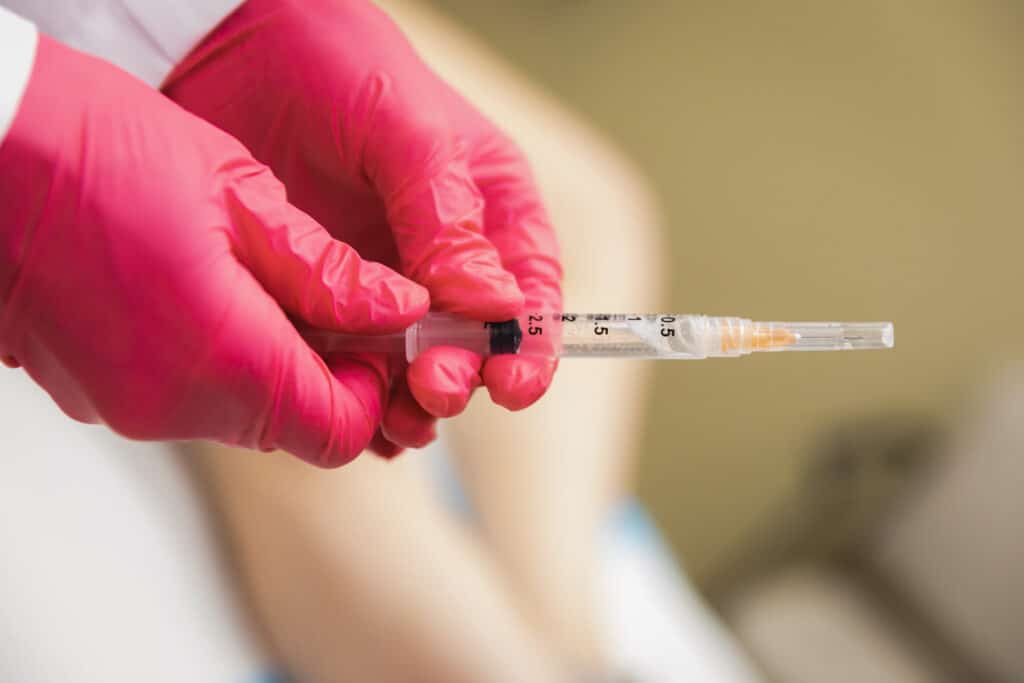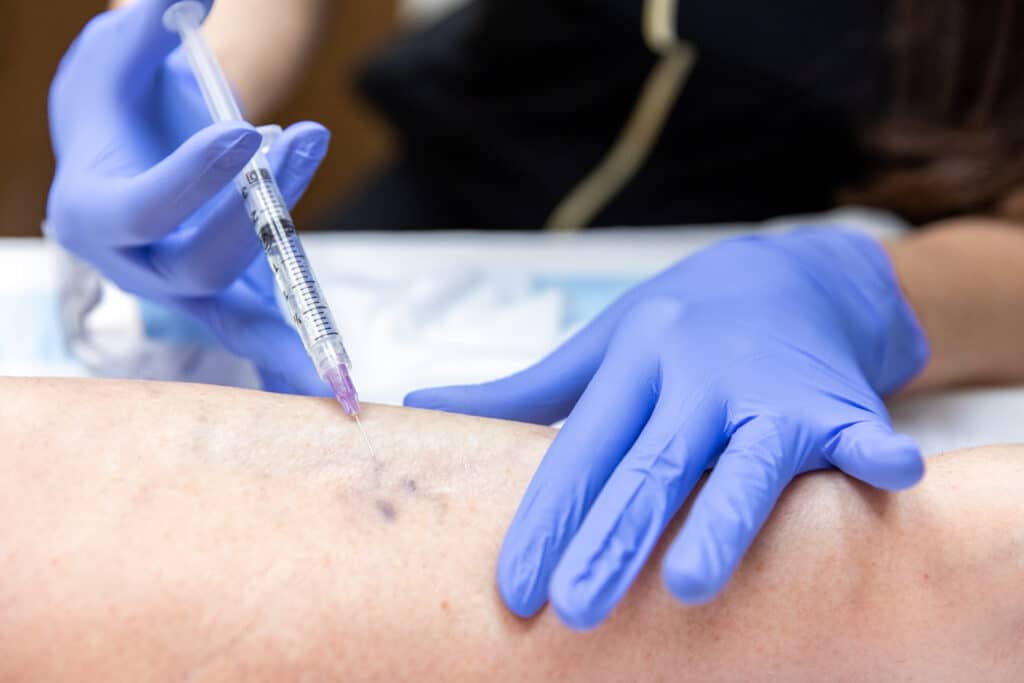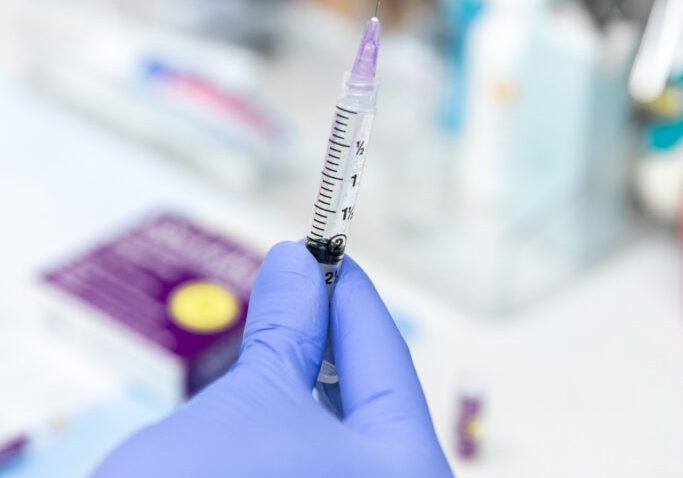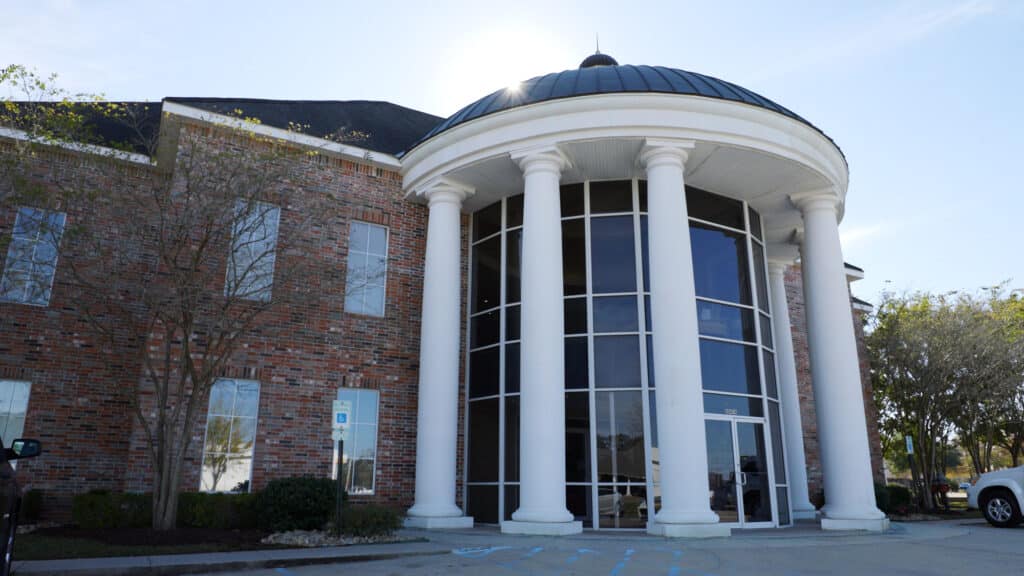WELCOME TO RENAISSANCE DERMATOLOGY & AESTHETICS Tackle Spider Veins with Sclerotherapy in Zachary
Spider veins, also known as Telangiectasia, appear as a collection of small, colored veins right beneath the skin’s surface. They’re typically blue, purple, or red, and their patterns often resemble a cobweb, hence the name. Spider veins are, in short, damaged veins. They usually form when the valves that control blow flow in your veins weaken.
While not an immediate health risk, they can cause discomfort and pain, and their appearance can impact your confidence. That’s why the team at Renaissance Dermatology & Aesthetics offers sclerotherapy in Zachary.
Treatment Details
Consultation Required?
Yes
Downtime:
Little to none
Sessions Needed:
2 to 4
Results Duration:
Permanent
What it Treats
Spider Veins
Why Try Sclerotherapy in Zachary?
Non-surgical
Sclerotherapy injections are a minimally invasive treatment that can entirely remove or fade spider veins.
Short Treatment Times
Sclerotherapy in Zachary requires no anesthesia and usually takes between 20 to 40 minutes to complete.
Little Downtime
You may experience some slight discomfort in the legs during the treatment, but once the procedure is over you can go about your day.
WHAT TO EXPECT The Sclerotherapy Process

Consultation
When you come to Renaissance Dermatology & Aesthetics for sclerotherapy in Zachary, Dr. Harrington will meet with you for a consultation. We make sure this is the best treatment for your needs and discuss your goals and desired results.
Treatment
Sclerotherapy injections are a minimally invasive treatment that can entirely remove or fade spider veins. Performed by certified dermatologists at Renaissance Dermatology & Aesthetics, the procedure has your physician inject a safe chemical directly into the spider vein. The chemical irritates the lining of the vein, causing it to slowly close and seal off. Your body will naturally redirect the blood normally carried through the now sealed vein, leaving you to live your life spider vein free!
PRE-TREATMENT Pre-Care Instructions
Prior to Sclerotherapy in Zachary, Renaissance Dermatology & Aesthetics Recommends:

Training
Avoid tanning 2 to 3 weeks before your sclerotherapy treatment.
NSAID Medications
Stop taking any NSAID medications (such as ibuprofen, Advil, Motrin), vitamin E, or herbal supplements that increase your chances of bruising 48 hours before treatment.
Clothing
Depending on where you’re receiving treatment, wear light, breathable clothing or shorts.
POST TREATMENT Post-Care Instructions
Following Sclerotherapy in Zachary, Renaissance Dermatology & Aesthetics Recommends:

Walking Around
Walk around directly after treatment to improve results and minimize the chance of bruising or discoloration of blood vessels in the treatment area.
Compression Stockings
Wear compression stockings after treatment. Depending on the area being treated, we recommend wearing them for up to 3 weeks.
Physician Instructions
Consult your physician to determine your care timeline. For up to 72 hours after treatment, patients should avoid: intense exercise, hot baths, saunas, prolonged sun exposure, and flights.
Frequently Asked Questions
Sclerotherapy, when performed appropriately by a specialist, is safe and effective. Common side effects are usually temporary and easily tolerated. These include itching, tenderness, skin bruising, and pigmentation, as well as the growth of fine vessels in the treated area.
If you are at all concerned, the team here at Renaissance Dermatology & Aesthetics is happy to talk you through the procedure. You can contact us to learn more about the treatment or receive an answer to any lingering questions you may have!
When you will see results from sclerotherapy will depend on various factors, namely:
- The technique of injection
- The type & strength of the solution used in sclerotherapy
- The density and thickness of the vessels in a given area
- The skin complexion of the patient.
In our experience, most spider veins disappear between 2 weeks and 2 months. Reticular veins may require more than 1 session to disappear. You should immediately see a dermatologist if your skin has areas that grow or change shape and color, aggressively itch, or do not heal. In addition, you should see dermatologists in Zachary if you have areas that ooze fluid or blood, crust or clot over, and then ooze or bleed again, as well as any sore that doesn’t heal after 2 weeks.
Nearly everyone is a good fit for sclerotherapy. There are some patients, however, who should either wait for treatment or pursue alternative treatment solutions to their spider veins. You should avoid leg vein sclerotherapy if you are bedridden, or cannot be physically active for whatever reason. You should also avoid sclerotherapy if you have a history of blood clots in the legs.
Pregnant women should not pursue sclerotherapy while pregnant or within 6 months after birth, as the risk to the baby during the pregnancy or to a woman’s body during recovery isn’t clearly understood.
Even compared with the best lasers, sclerotherapy is still the “gold standard” for the removal of most leg spider veins. Laser treatment is often reserved for only the tiniest of spider veins that don’t respond to sclerotherapy.
Yes, you should definitely wear some form of compression after sclerotherapy treatments. For most vessels other than the tiniest leg spider veins, compression is believed to increase the effectiveness and safety of the procedure. Compression enhances the effectiveness of the procedure by keeping the treated and injured vessels compressed and preventing the trapping of blood in them. This improves recovery time and prevents blood clots from forming following treatment. We will discuss what type of compression is recommended for your individual case.
There is a risk of skin pigmentation, though that risk varies from patient to patient. The chances of developing brown staining (pigmentation) after sclerotherapy is anywhere from less than 1% to about 30%. It is dependent on several factors: the nature and strength of the solution, the density, size, depth of the vessels treated, and skin complexion. Your physician will discuss the risks and likely outcomes of the treatment during your initial consultation and prior to the treatment.

Get Started
Renaissance Dermatology wants to help you achieve your aesthetic and dermatological goals
Complete our “Request an Appointment” form to get started on your journey.
